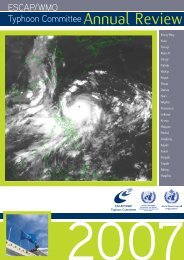TCAR - Typhoon Committee
TCAR - Typhoon Committee
TCAR - Typhoon Committee
You also want an ePaper? Increase the reach of your titles
YUMPU automatically turns print PDFs into web optimized ePapers that Google loves.
88<br />
ESCAP/WMO<br />
<strong>Typhoon</strong> <strong>Committee</strong> Annual Review 2009<br />
the STRIDE team were assigned at the NDCC<br />
office to brief concerned officials and the media<br />
on the status of tropical cyclone.<br />
· Aside from the regularly press conferences/<br />
briefings during the occurrence of a tropical<br />
cyclone inside PAR, simultaneously these<br />
warning bulletins and advisories are being sent to<br />
the different sectors of the society either through<br />
SMS or emails particularly to the affected areas.<br />
b. Hydrological Achievements/Results<br />
· Flood hazard mapping activities<br />
For CY 2009, flood hazard maps in the provinces<br />
of Benguet and Rizal and Zambales and storm<br />
surge hazard maps were completed. The<br />
hazard maps are provided to concerned local<br />
government units (LGUs) as inputs in updating<br />
their comprehensive land use plans (CLUPs).<br />
· Post flood investigations were conducted in<br />
the provinces of Zambales, Cagayan de Oro,<br />
Agusan del Sur, Cagayan, Pampanga, Nueva<br />
Ecija, Pangasinan, Metro Manila, Ilocos Norte,<br />
Ilocos Sur, La Union and Laguna.<br />
c. Disaster Prevention and Preparedness<br />
Achievements/Results<br />
Please refer to Key Result Area 1(c).<br />
d. Research, Training, and Other<br />
Achievements/Results<br />
Please refer to Key Result Area 1(d).<br />
e. Regional Cooperation Achievements/<br />
Results<br />
On 17 – 19 February 2009, the Philippines<br />
hosted the East and Southeast Asia Regional<br />
Flood Hazard Mapping Seminar aimed to<br />
strengthen the capacity of professionals who<br />
have acquired trainings in Japan and an avenue<br />
to share experiences on flood hazard mapping<br />
techniques and flood disaster management<br />
tools. The seminar was sponsored by the<br />
International Centre for Water Hazard and Risk<br />
Assessment (ICHARM), Public Works Research<br />
Institute (PWRI), JICA in coordination with the<br />
Government of the Philippines.<br />
Figure 4.e.1 Participants and guests in the East<br />
and Southeast Asia Regional Flood Hazard<br />
Mapping Seminar held in Manila on 17-19<br />
February 2009<br />
Eight (8) countries from East and Southeast Asia<br />
participated in the seminar as follows: Bangladesh,<br />
China, Indonesia, Malaysia, Vietnam, Cambodia<br />
Laos and the Philippines. Representatives from<br />
the <strong>Typhoon</strong> <strong>Committee</strong> and the Infrastructure<br />
Development Institute (IDI) of Japan attended the<br />
seminar.<br />
f. Identified Opportunities/Challenges for<br />
Future Achievements/Results<br />
The National Grid Corporation of the Philippines<br />
(NGCP) or the power grid operator got a<br />
significant boost when PAGASA agreed to<br />
share its real-time weather information through<br />
a memorandum of agreement signed on 24<br />
November 2009. Such information will be<br />
utilized during emergencies caused by severe<br />
weather conditions. The system is expected to<br />
pave the way for the quick implementation of<br />
contingency plans and activities that will help<br />
prepare for and mitigate the adverse effects<br />
of weather disturbances on both transmission<br />
facilities and the power customers as part of<br />
NGCP’s Storm Tracking Alert and Relay System<br />
(STARS). NGCP’s subscription to the weather<br />
and hydrometeorological data to support NGCP’s<br />
Integrated <strong>Typhoon</strong> Action Plan (ITAP).<br />
NGCP, on the other hand, will be providing<br />
back-up communication link to the PAGASA<br />
data center so as to transmit real-time hydrometeorological<br />
data from flood prone-areas,

















